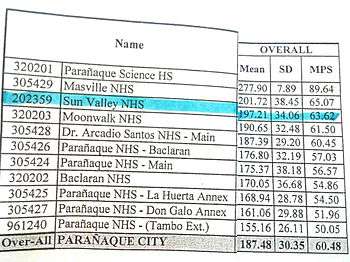National Achievement Test

The National Achievement Test (NAT), is a set of examinations taken in the Philippines by students in Years 6, 10, and 12. Students are given national standardised test, designed to determine their academic levels, strength and weaknesses. Their knowledge learnt throughout the year are divided into 5 categories; English, Filipino, Math, Science and Araling Panlipunan (Social Studies in English) and are tested for what they know.
NAT examinations aim to:
1. provide empirical information on the achievement level of pupils/students in Grades Six, Ten, and Twelve to serve as guide for policy makers, administrators, curriculum planners, supervisors, principals and teachers in their respective courses of action.
2. identify and analyze variations on achievement levels across the years by region, division, school and other variables
3. determine the rate of improvement in basic education with respect to individual schools within certain time frames.
History of the National Achievement TesT
The NCEE was abolished in 1994 through Executive Order no. 632 by then education secretary Raul Roco and was replaced by the NEAT and NSAT. Since then the NAT used to be called the National Elementary Achievement Test (NEAT) for the grade school level and the National Secondary Achievement Test (NSAT) for the high school level.When the Department of Education, Culture and Sports (DECS) was officially converted into the Department of Education (Deped), NEAT and NSAT were also abolished and replaced by the National Achievement Test. Both the public and private elementary schools take this exam.
After a long year of waiting of other examination since many students and teacher and complaining about some of the longest test examination that the DepEd have, so Dr. Jesli Lapus or the Secretary of DepEd in started of year 2006; he was the first secretary among the all secretaries of the past DepEd years that created this idea.
Records
Records are called the group of each school not region that fair the examination of scoring and making base of all regional directors of the DepEd. Regional Directors are the leader of making records or putting all records in one table of list. It is the base regions of all directors and section, if one section is departed; it was continuously open for all directors.
To make a records of all scores, it is either statistics or even an ordinary statistic recording. To find the smartest section of region in the Philippines, they should examine all scores and check for the highest attained scores among all, then the DepEd or the Regional Directors will decided if the records are permanently being stated or permanently unstated.
In Visayas, there are only 5 regional directors and those are Negros Occidental, Iloilo, Cebu, Bohol, and Samar. Those regions are the state regional directors only at the Visayas Region; however NAT should be checked by either regional directors or manual checking by some students.
In Mindanao, there are only 2 regional directors and those are Cotabato and Zamboanga. They are the only two that could check together like the Zamboanga Region will be checking through the Cotabato Region or even like an opposite checking method. They don't want to check by manual by some students because of they're not sure to be trusted to check or not.
| Grade/Year | Taken by: | Description/Other |
|---|---|---|
| Grade 6 (Elementary) | All section within the whole students, it could be excluded if exited for permission. | Grade 6 NAT examination should be taken by whoever will take the examination to go to junior high school. |
| Grade 10 (Junior High School) | All students could get this examination. | Grade 10 NAT examination should be taken by whoever will take the examination to go to senior high school. |
External links
- National Educational Testing and Research Center – DepEd Philippines at the Wayback Machine (archived May 9, 2012)